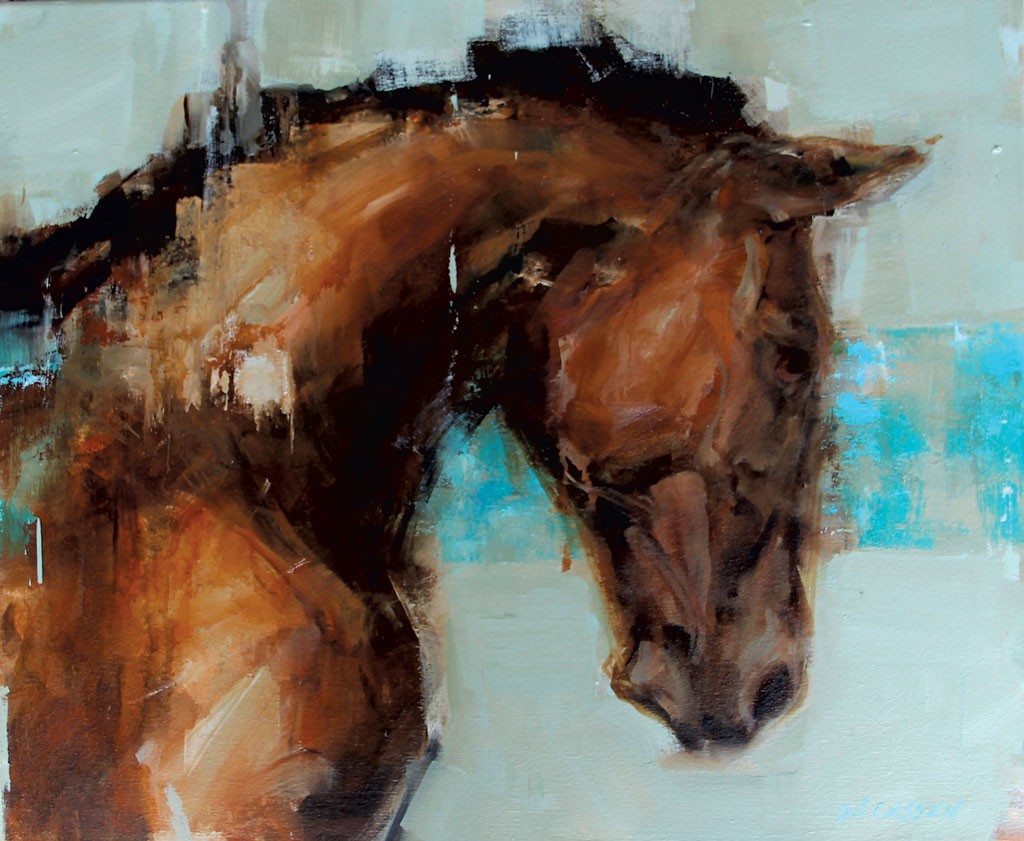
- "Blue Horse" by Georganna Lennsen
West Branch Gallery & Sculpture Park has steadily evolved in the past 13-plus years since painter Tari Swenson and sculptor Chris Curtis first held a contemporary art show in their 12,500-square-foot warehouse in Stowe. The married duo had used the former indoor tennis court as a studio for some years. Eventually, heavy and unsolicited visitor traffic inspired them to transform part of the capacious building into a gallery and display sculptures outside on the sprawling, shady lawn.
"Chris would be outside drilling or sand blasting or pounding, and people would mosey over from the bike path and just love what they'd encounter," remembers Swenson. "I had a small studio in the warehouse, where the main gallery is now. We started thinking: All of these people are just kind of walking in; we have the building — why don't we make a space?"
West Branch's inaugural exhibit was titled "10 Stowe Artists"; its initial roster of exhibitors was a few of the owners' contemporary artist friends who tended not to show their work in Vermont, according to Swenson. It's now a premier contemporary art destination.
Entering 2015 — the gallery's 14th year — West Branch carries more than 60 sculptors and two-dimensional artists. It's kicking off an exhibition calendar that its owners call the "most ambitious" program in its history, starting with a playful exhibit of animal sculptures and paintings titled "Menagerie: Animals in Art" (January 3 to March 29) and an exhibit called "Endless Beginnings: Nonrepresentational Art Today" (January 24 to April 19.)
The complete schedule will be released in February, but the owners promise that it features "frequently changing, curated exhibits" in each of West Branch's four exhibition spaces. Those include the main gallery; the outdoor sculpture park; a small, loft-style upstairs gallery; and a 630-square-foot wing on the south end of the building added in March 2014, which until recently was dedicated to representational landscapes.
Swenson notes that while the gallery's growth has happened "very organically," the owners are stepping up efforts to plan exhibits months — and even years — into the future. That doesn't mean they've lost their spontaneity, Curtis adds. They're planning an impromptu pop-up exhibit for one of their artists, Jonathan Prince, who was recently featured on the cover of Art New England.
To keep up with the rising curatorial responsibilities and to amp up the gallery's blogging and online presence, the owners recently hired Ric Kasini Kadour, a Montréal-based artist, writer and former gallerist who publishes Art Map Burlington and contributes regularly to Art New England. Kadour's role includes curating and contributing to West Branch's blog and press materials.
Swenson and Curtis are also reimagining the way artwork is displayed in the gallery's multiple exhibition spaces. Most notably, the owners have chosen to integrate West Branch's representational landscapes into each of the indoor gallery areas.
Swenson says the change is not due to the landscapes' sales performance, but rather to an "intuitive" sense that the landscape wing was becoming a stale experience for viewers. Curtis adds that, unlike many contemporary galleries, West Branch sees its sales driven not by two-dimensional work but by sculpture, which brought in more than 60 percent of the gallery's revenue in 2013. Last year, that figure dropped to just under 50 percent, which is still unusually high. Total sales in 2014 were up by 5 percent from the previous year, Swenson adds — giving the lie to the idea that contemporary art does not sell in Vermont.
Adding landscape work to the gallery's holdings was a departure for West Branch, Swenson notes. Previously, the gallery had carried painters with high levels of technical ability whose subject matter tended to be less traditional than a representational landscape. And Swenson admits her own inclinations evolved: "For me, photorealism never felt emotive," she says, "and for me that's the reason to have art on your wall."
Then she happened across some realistic images that she loved. In particular, she saw painting of houses by Lincoln artist Kathleen Kolb and found herself captivated by Kolb's use of light. Soon after, painter Gabriel Tempesta stopped by with paintings of bees, and Swenson once again "fell in love," as she puts it.
West Branch's "Landscape Traditions" wing opened with nine artists; several will remain with the gallery even as the wing concept dissolves. That style of work, as both owners observe, draws a wide range of viewers to the gallery, including those without an art background — and that's the goal.
"Our patrons pay the way for all those other people who just wander in," Curtis says. "And we smile and say, 'That's great! Take away as much beauty as you can.'"









Comments
Comments are closed.
From 2014-2020, Seven Days allowed readers to comment on all stories posted on our website. While we've appreciated the suggestions and insights, right now Seven Days is prioritizing our core mission — producing high-quality, responsible local journalism — over moderating online debates between readers.
To criticize, correct or praise our reporting, please send us a letter to the editor or send us a tip. We’ll check it out and report the results.
Online comments may return when we have better tech tools for managing them. Thanks for reading.